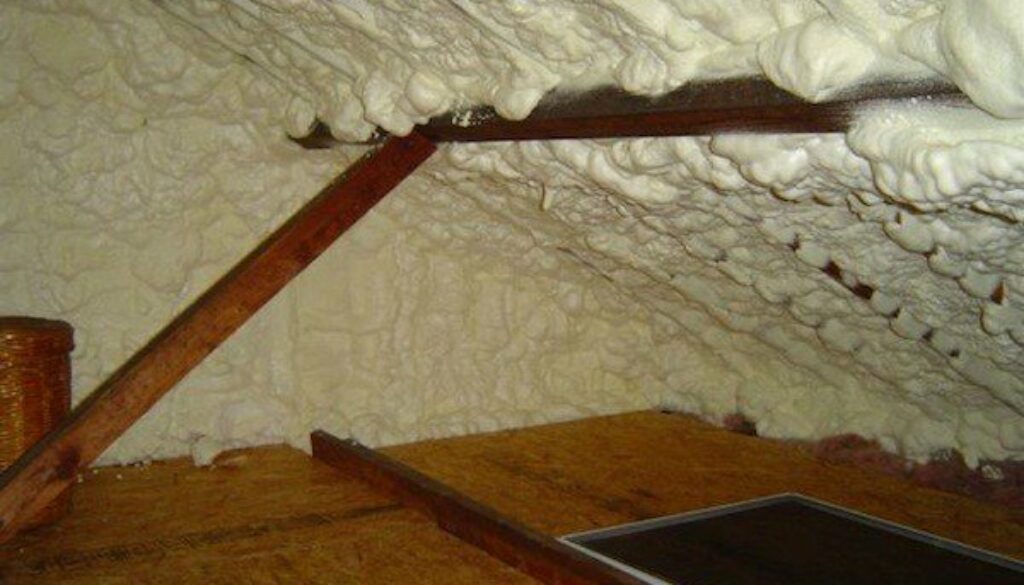The Do’s and Don’ts of Spray Foam Insulation
Spray Foam Do’s and Don’ts
More than once we have encountered mold and rot issues with spray foam insulation. The ability of foam insulation to control drafts and lower the energy costs of heating and cooling your home far exceeds that of traditional insulation. However, the same ability of spray foam to seal out drafts can also seal in moisture. Careful practice and consideration must be applied during construction and installation to prevent these issues.
There are two different types of spray insulation, open and closed cell. Open cell has a lower R-value than closed cell, allows moisture to be absorbed and pass through it, and is cheaper. Closed cell provides a greater thermal resistance and vapor resistance and seals out moisture. Both can be effective, with minimal issues, depending upon how and in what application they are applied.
Let’s consider the different components of your home and how they are constructed, to better understand the issues that can occur.
One of the common places we see problems with spray foam insulation is the roof. Your roof is constructed with rafters or trusses that are covered by a layer of plywood, commonly called the roof deck. The plywood serves as a base for the waterproofing membrane and most often an asphalt shingle covering. When spray foam is applied to the attic side of the framing and wood decking, it can seal moisture from the roof surface from entering the attic space in the case of closed cell, or it can slow the transfer of moisture into the attic space and accumulate in the porous wood and insulation materials, or condense in cooler areas of the home in the case of open cell. When the roof decking is installed it is important to keep it dry.
If closed cell insulation, the exterior waterproofing membrane, and shingles, are installed on a damp roof deck, the moisture can be trapped in the permeable wood decking and framing and cause major problems. If an open cell is installed, the moisture can migrate to areas of lower humidity but will be trapped in the attic space if it is unventilated or not climate-controlled. Both scenarios can be troublesome.
Another problem that can occur in closed-cell insulation is solar vapor drive. When the sun heats up the roof surface, moisture that exists under the shingles can vaporize and be driven through the waterproofing membrane into the roof deck. If closed cell insulation seals the underside of the roof deck, the moisture becomes trapped in the wood and can cause deterioration of the decking and framing over time.
In cases of open-cell insulation, this moisture can make its way to the attic space. This can cause high humidity and condensation in areas of the home that should remain dry. If the attic space is not ventilated, the humidity transfer with open cell insulation from the solar vapor drive can be very high.
The question becomes, if you are trying to insulate your house from outside temperatures, why would you ventilate on the back side of the insulated barrier? You wouldn’t. If you did this, the insulation would serve no purpose. For this reason, closed-cell insulation should be the insulation of choice for attic spaces that are not climate or humidity-controlled. However, that doesn’t mean there is no possibility of a problem.
If you aren’t circulating the air inside the attic space there can be problems with either option. Temperature and humidity differentials can still occur from the inside of the home with closed-cell insulation. If the moisture cannot get out through the insulation from the inside of the home and builds up in the attic space, mold can become an issue.
A knowledgeable professional will be able to explain and install a system for moisture and climate protection that ensures that these problems do not arise. If you encounter a contractor who is quick to dismiss the concerns with spray foam insulation, you should be skeptical that he/she will carefully evaluate and design these systems to minimize the possibility of problems in the future. Improperly designed and installed systems can lead to catastrophic damage and financial burden upon you and your family.
